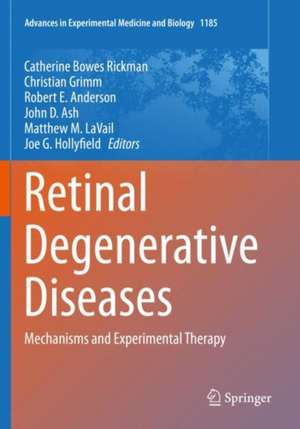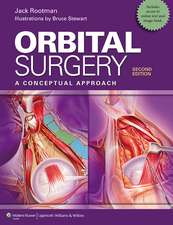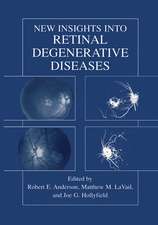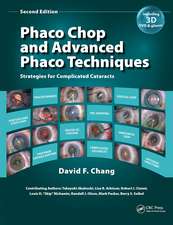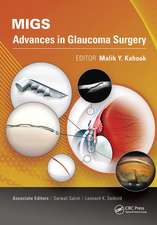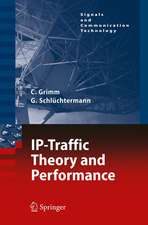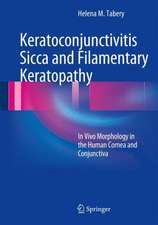Retinal Degenerative Diseases: Mechanisms and Experimental Therapy: Advances in Experimental Medicine and Biology, cartea 1185
Editat de Catherine Bowes Rickman, Christian Grimm, Robert E. Anderson, John D. Ash, Matthew M. Lavail, Joe G. Hollyfielden Limba Engleză Paperback – 17 ian 2021
The volume presents representative state-of-the-art research in almost all areas of retinal degenerations, ranging from cytopathologic, physiologic, diagnostic and clinical aspects; animal models; mechanisms of cell death; candidate genes,cloning, mapping and other aspects of molecular genetics; and developing potential therapeutic measures such as gene therapy and neuroprotective agents for potential pharmaceutical therapy.
While advances in these areas of retinal degenerations were described, there will be many new topics that either are in their infancy or did not exist at the time of the last RD Symposium, RD2016. These include the role of inflammation and immunity, as well as other basic mechanisms, in age-related macular degeneration, several new aspects of gene therapy, and revolutionary new imaging and functional testing that will have a huge impact on the diagnosis and following the course of retinal degenerations, as well as to provide new quantitative endpoints for clinical trials.
The retina is an approachable part of the central nervous system (CNS), and there is a major interest in neuroprotective and gene therapy for CNS diseases and neurodegenerations, in general. It should be noted that with successful and exciting initial clinical trials in neuroprotective and gene therapy, including the restoration of sight in blind children, the retinal degeneration therapies are leading the way towards new therapeutic measures for neurodegenerations of the CNS. Many of the successes recently reported in these areas of retinal degeneration sprang from collaborations established at previous RD Symposia, and many of those were reported at the RD2016 meeting and included in the current volume. We anticipate the excitement of those working in the field and those afflicted with retinal degenerations is reflected in the volume.
| Toate formatele și edițiile | Preț | Express |
|---|---|---|
| Paperback (3) | 1835.39 lei 43-57 zile | |
| Springer International Publishing – 14 feb 2019 | 1835.39 lei 43-57 zile | |
| Springer – 3 sep 2016 | 2138.05 lei 43-57 zile | |
| Springer International Publishing – 17 ian 2021 | 2444.70 lei 43-57 zile | |
| Hardback (3) | 1841.85 lei 43-57 zile | |
| Springer International Publishing – 3 mai 2018 | 1841.85 lei 43-57 zile | |
| Springer – 25 mar 2014 | 2142.61 lei 43-57 zile | |
| Springer International Publishing – 29 dec 2019 | 2453.69 lei 43-57 zile |
Din seria Advances in Experimental Medicine and Biology
- 9%
 Preț: 719.56 lei
Preț: 719.56 lei - 5%
 Preț: 717.20 lei
Preț: 717.20 lei - 20%
 Preț: 691.93 lei
Preț: 691.93 lei - 5%
 Preț: 715.71 lei
Preț: 715.71 lei - 5%
 Preț: 1113.83 lei
Preț: 1113.83 lei - 5%
 Preț: 1031.00 lei
Preț: 1031.00 lei - 15%
 Preț: 640.24 lei
Preț: 640.24 lei - 5%
 Preț: 717.00 lei
Preț: 717.00 lei - 5%
 Preț: 820.42 lei
Preț: 820.42 lei - 5%
 Preț: 717.00 lei
Preț: 717.00 lei - 5%
 Preț: 715.35 lei
Preț: 715.35 lei - 5%
 Preț: 716.28 lei
Preț: 716.28 lei - 5%
 Preț: 716.28 lei
Preț: 716.28 lei - 15%
 Preț: 641.38 lei
Preț: 641.38 lei - 20%
 Preț: 1161.71 lei
Preț: 1161.71 lei - 5%
 Preț: 1170.51 lei
Preț: 1170.51 lei - 18%
 Preț: 1119.87 lei
Preț: 1119.87 lei - 5%
 Preț: 1288.48 lei
Preț: 1288.48 lei - 5%
 Preț: 1164.67 lei
Preț: 1164.67 lei - 5%
 Preț: 1101.73 lei
Preț: 1101.73 lei - 18%
 Preț: 1123.67 lei
Preț: 1123.67 lei - 5%
 Preț: 1435.64 lei
Preț: 1435.64 lei - 20%
 Preț: 1044.10 lei
Preț: 1044.10 lei - 18%
 Preț: 946.39 lei
Preț: 946.39 lei - 5%
 Preț: 292.57 lei
Preț: 292.57 lei - 18%
 Preț: 957.62 lei
Preț: 957.62 lei - 18%
 Preț: 1235.76 lei
Preț: 1235.76 lei - 5%
 Preț: 1231.55 lei
Preț: 1231.55 lei - 5%
 Preț: 1292.30 lei
Preț: 1292.30 lei - 5%
 Preț: 1102.10 lei
Preț: 1102.10 lei - 18%
 Preț: 1132.81 lei
Preț: 1132.81 lei - 5%
 Preț: 1165.19 lei
Preț: 1165.19 lei - 5%
 Preț: 1418.48 lei
Preț: 1418.48 lei - 5%
 Preț: 1305.63 lei
Preț: 1305.63 lei - 18%
 Preț: 1417.72 lei
Preț: 1417.72 lei - 18%
 Preț: 1412.99 lei
Preț: 1412.99 lei - 24%
 Preț: 806.15 lei
Preț: 806.15 lei - 18%
 Preț: 1243.29 lei
Preț: 1243.29 lei - 5%
 Preț: 1429.44 lei
Preț: 1429.44 lei - 5%
 Preț: 1618.70 lei
Preț: 1618.70 lei - 5%
 Preț: 1305.12 lei
Preț: 1305.12 lei - 18%
 Preț: 1124.92 lei
Preț: 1124.92 lei - 5%
 Preț: 1097.54 lei
Preț: 1097.54 lei - 15%
 Preț: 649.87 lei
Preț: 649.87 lei - 5%
 Preț: 1097.54 lei
Preț: 1097.54 lei - 18%
 Preț: 945.79 lei
Preț: 945.79 lei - 5%
 Preț: 1123.13 lei
Preț: 1123.13 lei - 20%
 Preț: 816.43 lei
Preț: 816.43 lei
Preț: 2444.70 lei
Preț vechi: 2573.37 lei
-5% Nou
Puncte Express: 3667
Preț estimativ în valută:
467.84€ • 485.47$ • 391.04£
467.84€ • 485.47$ • 391.04£
Carte tipărită la comandă
Livrare economică 17-31 martie
Preluare comenzi: 021 569.72.76
Specificații
ISBN-13: 9783030273804
ISBN-10: 3030273806
Pagini: 596
Ilustrații: XVI, 596 p. 125 illus., 82 illus. in color.
Dimensiuni: 178 x 254 mm
Greutate: 1.05 kg
Ediția:1st ed. 2019
Editura: Springer International Publishing
Colecția Springer
Seria Advances in Experimental Medicine and Biology
Locul publicării:Cham, Switzerland
ISBN-10: 3030273806
Pagini: 596
Ilustrații: XVI, 596 p. 125 illus., 82 illus. in color.
Dimensiuni: 178 x 254 mm
Greutate: 1.05 kg
Ediția:1st ed. 2019
Editura: Springer International Publishing
Colecția Springer
Seria Advances in Experimental Medicine and Biology
Locul publicării:Cham, Switzerland
Textul de pe ultima copertă
This book contains the proceedings of the XVIII International Symposium on Retinal Degeneration (RD2018). A majority of those who spoke and presented posters at the meeting contributed to this volume. The blinding diseases of inherited retinal degenerations have no treatments, and age-related macular degeneration has no cures, despite the fact that it is an epidemic among the elderly, with 1 in 3-4 affected by the age of 70. The RD Symposium focused on the exciting new developments aimed at understanding these diseases and providing therapies for them. Since most major scientists in the field of retinal degenerations attend the biennial RD Symposia, they are known by most as the “best” and “most important” meetings in the field.
The volume presents representative state-of-the-art research in almost all areas of retinal degenerations, ranging from cytopathologic, physiologic, diagnostic and clinical aspects; animal models; mechanisms of cell death; candidate genes, cloning, mapping and other aspects of molecular genetics; and developing potential therapeutic measures such as gene therapy and neuroprotective agents for potential pharmaceutical therapy.
While advances in these areas of retinal degenerations were described, there will be many new topics that either are in their infancy or did not exist at the time of the last RD Symposium, RD2016. These include the role of inflammation and immunity, as well as other basic mechanisms, in age-related macular degeneration, several new aspects of gene therapy, and revolutionary new imaging and functional testing that will have a huge impact on the diagnosis and following the course of retinal degenerations, as well as to provide new quantitative endpoints for clinical trials.
The retina is an approachable part of the central nervous system (CNS), and there is a major interest in neuroprotective and gene therapy for CNS diseases and neurodegenerations, in general. It should be noted that with successful and exciting initial clinical trials in neuroprotective and gene therapy, including the restoration of sight in blind children, the retinal degeneration therapies are leading the way towards new therapeutic measures for neurodegenerations of the CNS. Many of the successes recently reported in these areas of retinal degeneration sprang from collaborations established at previous RD Symposia, and many of those were reported at the RD2016 meeting and included in the current volume. We anticipate the excitement of those working in the field and those afflicted with retinal degenerations is reflected in the volume.
The volume presents representative state-of-the-art research in almost all areas of retinal degenerations, ranging from cytopathologic, physiologic, diagnostic and clinical aspects; animal models; mechanisms of cell death; candidate genes, cloning, mapping and other aspects of molecular genetics; and developing potential therapeutic measures such as gene therapy and neuroprotective agents for potential pharmaceutical therapy.
While advances in these areas of retinal degenerations were described, there will be many new topics that either are in their infancy or did not exist at the time of the last RD Symposium, RD2016. These include the role of inflammation and immunity, as well as other basic mechanisms, in age-related macular degeneration, several new aspects of gene therapy, and revolutionary new imaging and functional testing that will have a huge impact on the diagnosis and following the course of retinal degenerations, as well as to provide new quantitative endpoints for clinical trials.
The retina is an approachable part of the central nervous system (CNS), and there is a major interest in neuroprotective and gene therapy for CNS diseases and neurodegenerations, in general. It should be noted that with successful and exciting initial clinical trials in neuroprotective and gene therapy, including the restoration of sight in blind children, the retinal degeneration therapies are leading the way towards new therapeutic measures for neurodegenerations of the CNS. Many of the successes recently reported in these areas of retinal degeneration sprang from collaborations established at previous RD Symposia, and many of those were reported at the RD2016 meeting and included in the current volume. We anticipate the excitement of those working in the field and those afflicted with retinal degenerations is reflected in the volume.
Cuprins
Part I Age-Related Macular Degeneration (AMD).- Oxidative Stress Regulation and DJ-1 function in the Retinal Pigment Epithelium: implications for AMD.- Mitochondria: Potential Targets for Protection in Age-Related Macular Degeneration.- Toll-Like Receptors and Age-Related Macular Degeneration.- Alterations in Extracellular Matrix/Bruch’s Membrane can cause the Activation of the Alternative Complement Pathway via Tick-over.- MicroRNA as Therapeutics for Age Related Macular Degeneration.- Anaphylatoxin Signaling in Retinal Pigment and Choroidal Endothelial Cells: Characteristics and Relevance to Age-Related Macular Degeneration.- Estimations of Retinal Blue-Light Irradiance Values and Melatonin Suppression Indices Through Clear and Yellow-Tinted Intraocular Lenses.- Co-expression of wild-type and mutant S163R C1QTNF5 in retinal pigment epithelium.- Part II Gene Therapies.- Mini-Review: Cell Type Specific Optogenetic Vision Restoration Approaches.- Mutation-Independent Gene Therapies for Rod-Cone Dystrophies.- Antisense Oligonucleotide-Based Splice Correction of a Deep-Intronic Mutation in CHM Underlying Choroideremia.- Gene Therapy Approaches to Treat the Neurodegeneration and Visual Failure in Neuronal Ceroid Lipofuscinoses.- Success of Gene Therapy in Late-Stage Treatment.- Optimizing Non-Viral Gene Therapy Vectors for Delivery to Photoreceptors and Retinal Pigment Epithelial Cells.- Nanoparticles as Delivery Vehicles for the Treatment of Retinal Degenerative Diseases.- Over Expression of Type 3 Iodothyronine Deiodinase Reduces Cone Death in the Leber Congenital Amaurosis Model Mice.- Part III In-Vivo Diagnostics for Structure and Function.- In Vivo Functional Imaging of Retinal Neurons Using Red and Green Fluorescent Calcium Indicators.- Optimizing ERG Measures of Scotopic and Photopic Critical Flicker Frequency.- Repeatability and Reproducibility of In Vivo Cone Density Measurements in the Adult Zebrafish Retina.- Normative Retinal Thicknesses inCommon Animal Models of Eye Disease Using Spectral Domain Optical Coherence Tomography.- A Novel Approach for Integrating AF-SLO and SDOCT Imaging Data Demonstrates the Ability to Identify Early Retinal Abnormalities in Mutant Mice and Evaluate the Effects of Genetic and Pharmacological Manipulation.- Part IV Inflammation and Angiogenesis.- The Role of Hypoxia, Hypoxia-Inducible Factor (HIF) and VEGF In Retinal Angiomatous Proliferation.- Neuroinflammation in Retinitis Pigmentosa, Diabetic Retinopathy and Age-related Macular Degeneration: A Minireview.- Autoimmune Retinopathy: An Immunologic Cellular-Driven Disorder.- Inflammation-Induced Photoreceptor Cell Death.- Sall1 Regulates Microglial Morphology Cell Autonomously in the Developing Retina.- Part V Inherited Retinal Degenerations.- Whole-Exome Sequencing Identifies Novel Variants that Co-Segregates with Autosomal Recessive Retinal Degeneration in a Pakistani Pedigree.- Identification of Novel Deletions as the Underlying Causeof Retinal Degeneration in Two Pedigrees.- Molecular Findings in Families with an Initial Diagnose of Autosomal Dominant Retinitis Pigmentosa (Adrp).- Pleiotropic Effects of Risk Factors in Age-Related Macular Degeneration and Seemingly Unrelated Complex Diseases.- Mapping of Canine Models of Inherited Retinal Diseases.- A Mini-Review: Leber Congenital Amaurosis; Identification of Disease-Causing Variants, and Personalised Therapies.- Part VI Mechanisms of Degeneration.- Role of Fibulins 2 & 5 in Retinal Development and Maintenance.- Identifying Key Networks Linked to Light-Independent Photoreceptor Degeneration in Visual Arrestin 1 Knockout Mice.- How Excessive Cgmp Impacts Metabolic Proteins in Retinas at the Onset of Degeneration.- Protein Carbonylation–Dependent Photoreceptor Cell Death Induced by N-Methyl-N-Nitrosourea in Mice.- Müller Glia Reactivity and Development of Gliosis in Response to Pathological Conditions.- Underdeveloped RPE Apical Domain Underlies Lesion Formationin Canine Bestrophinopathies.- Binary Function of ARL3-GTP Revealed by Gene Knockouts.- Do cGMP Levels Drive the Speed of Photoreceptor Degeneration?.- Early endosome morphology in health and disease.- The Retinal Circadian Clock and Photoreceptors Viability.- The Role of C-Jun N-Terminal Kinase (JNK) in Retinal Degeneration and Vision Loss.- The Evaluation of BMI1 Posttranslational Modifications During Retinal Degeneration to Understand BMI1 Action on Photoreceptor Death Execution.- PKG-Dependent Cell Death in 661W Cone Photoreceptor-Like Cell Cultures.- Impact of MCT1 Haploinsufficiency on the Mouse Retina.- The Leber Congenital Amaurosis-Linked Protein AIPL1 and its Critical Role in Photoreceptors.- Alternative Splicing for Activation of Coagulation Factor XIII-A in the Fish Retina After Optic Nerve Injury.- Bisretinoid Photodegradation is Likely Not a Good Thing.- Further Characterization of the Predominant Inner Retinal Degeneration of Aging Cln3Δex7/8 Knock-in Mice.- Differential Exon Expression in a Large Family of Retinal Genes is Regulated By a Single Trans Locus.- Molecular Chaperone Erp29: A Potential Target for Cellular Protection in Retinal and Neurodegenerative Diseases.- The Role of Microbiota in Retinal Disease.- Part VII Neuroprotection.- Current Pharmacological Concepts in the Treatment of the Retinitis Pigmentosa.- Valproic Acid Inhibits Human Retinal Pigment Epithelial (hRPE) Cell Proliferation via a P38 MAPK Signaling Mechanism.- Pigment Epithelium-derived Factor Protects Retinal Pigment Epithelial Cells against Cytotoxicity “In Vitro”.- Brain Derived Neurotrophic Factor as a Treatment Option for Retinal Degeneration.- VEGF as a Trophic Factor for Müller Glia in Hypoxic Retinal Diseases.- Müller Cell Biological Processes Associated with Leukemia Inhibitory Factor Expression.- Retbindin is Capable of Protecting Photoreceptors from Flavin-sensitized Light-mediated Cell Death In Vitro.- Constitutive Activation Mutant mTOR Promote Cone Survival in Retinitis Pigmentosa Mice.- Maintaining Cone Function in Rod-Cone Dystrophies.- Primary Rod and Cone Degeneration is Prevented by HDAC Inhibition.- Part IIX Retinal Cell Biology.- More than meets the eye: current understanding of RPGR function.- Polarized Exosome Release from the Retinal Pigmented Epithelium.- The Impact of Adherens and Tight Junctions on Physiological Function and Pathological Changes in the Retina.- TRPV4 Does Not Regulate the Distal Retinal Light Response.- Role of Sirtuins in Retinal Function Under Basal Conditions.- The Retinol Binding Protein Receptor 2 (Rbpr2) is Required for Photoreceptor Survival and Visual Function in the Zebrafish.- Opposite Roles of MerTK Ligands Gas6 and Protein S During Retinal Phagocytosis.- Redundant and Non-Redundant Functions of Akt Isoforms in the Retina.- Photoreceptor Outer Segment Isolation from a Single Canine Retina for RPE Phagocytosis Assay.- Preservation of Photoreceptor Nanostructure for Electron Tomography Using Transcardiac Perfusion Followed by High Pressure Freezing and Freeze-Substitution.- Microtubule-Associated Protein 1 Light Chain 3 (LC3) Isoforms in RPE and Retina.- Part IX Stem Cells.- The Ipsc-derived Retinal Tissue as a Tool to Study Growth Factor Production in the Eye.- Stem Cell-Based RPE Therapy for Retinal Diseases: Engineering 3D Tissues Amenable for Regenerative Medicine.- Validation of IPS Cell-derived RPE Tissue in Animal Models.- Cell Transplantation for Retinal Degeneration: Transition from Rodent to Non-Human Primate ModelsCell Transplantation for Retinal Degeneration: Transition from Rodent to Non-Human Primate Models.
Notă biografică
John D. Ash, Ph.D., Francis M. Bullard Eminent Scholar Chair in Ophthalmological Sciences, Department of Ophthalmology, College of Medicine at the University of Florida. Dr. Ash received his Ph.D. from the Ohio State University Biochemistry Program in 1994, and completed postdoctoral training in the Cell Biology Department at Baylor College of Medicine, in Houston, Texas, and began his faculty career at the University of Oklahoma Health Sciences Center, Oklahoma. Dr. Ash is also a Visiting Professor at the Dalian Medical University, Dalian China. Dr. Ash has written and published 60 manuscripts including research articles, book chapters and invited reviews, and has edited four books. He is currently an Executive editor for Experimental Eye research and a Scientific Review Editor for Molecular Vision. Dr. Ash is an active reviewer for these journals as well as Investigative Ophthalmology & Visual Science. In 2009, Dr. Ash received a research award from Hope for Vision, and in 2010 he received a Lew R. Wasserman Merit award from Research to Prevent Blindness, Inc. Dr. Ash has received grants from the National Institutes of Health, the Foundation Fighting Blindness, Research to Prevent Blindness, Inc., Hope for Vision, and the American Diabetes Association. Dr. Ash has served on the Program and Advocacy committees of the Association for Research in Vision and Ophthalmology. Dr. Ash has served on the scientific review panel for Fight For Sight (2005-2008) and is currently serving on the Scientific Advisory Board of the Foundation Fighting Blindness (Columbia, MD) where he chairs the review committee on Novel Medical Therapies Program. He also serves on the scientific review panel for the Macular Degeneration program of the BrightFocus Foundation (formerly the American Health Assistance Foundation, Clarksburg, MD).
Robert Eugene Anderson, MD, Ph.D., is George Lynn Cross Research Professor, Dean A. McGee Professorof Ophthalmology, Professor of Cell Biology, and Adjunct Professor of Geriatric Medicine at The University of Oklahoma Health Sciences Center in Oklahoma City, Oklahoma. He is also Director of Research at the Dean A. McGee Eye Institute. He received his Ph.D. in Biochemistry (1968) from Texas A&M University and his MD from Baylor College of Medicine in 1975. In 1968, he was a postdoctoral fellow at Oak Ridge Associated Universities. At Baylor, he was appointed Assistant Professor in 1969, Associate Professor in 1976, and Professor in 1981. He joined the faculty of the University of Oklahoma Health Sciences Center in January of 1995. Dr. Anderson served as director of the Oklahoma Center for Neuroscience (1995-1999) and chairman of the Department of Cell Biology (1998-2007). He has received several honorary appointments including Visiting Professor, West China School of Medicine, Sichuan University, Chengdu, China; Honorary Professorship, Xi’an Jiaotong University, Xi’an, China; and Honorary Professor of Sichuan Medical Science Academy, Sichuan Provincial People’s Hospital, Sichuan, China. Dr. Anderson has received the Sam and Bertha Brochstein Award for Outstanding Achievement in Retina Research from the Retina Research Foundation (1980), and the Dolly Green Award (1982) and two Senior Scientific Investigator Awards (1990 and 1997) from Research to Prevent Blindness, Inc. He received an Award for Outstanding Contributions to Vision Research from the Alcon Research Institute (1985), and the Marjorie Margolin Prize (1994). He has served on the editorial boards of Investigative Ophthalmology and Visual Science, Journal of Neuroscience Research, Neurochemistry International, Current Eye Research, and Experimental Eye Research. Dr. Anderson has published extensively in the areas of lipid metabolism in the retina and biochemistry of retinal degenerations. He has edited 18 books, 17 on retinal degenerations and one on the biochemistry of the eye. Dr. Anderson has receivedgrants from the National Institutes of Health, The Retina Research Foundation, the Foundation Fighting Blindness, and Research to Prevent Blindness, Inc. He has been an active participant in the program committees of the Association for Research in Vision and Ophthalmology (ARVO) and was a trustee representing the Biochemistry and Molecular Biology section. He was named a Gold Fellow by ARVO in 2009 and received the Proctor Medal from ARVO in 2011. He received the Llura Liggett Gund Lifetime Achievement Award from the Foundation Fighting Blindness in June 2011. In 2012, he received the Paul A. Kayser International Award, Retina Research Foundation. He received a Special Recognition Award from the ARVO Foundation in 2016 and was named a Fellow (Inaugural class of 12) of the International Society for the Study of Fatty Acids and Lipids (ISSFAL). In 2016, the Dean McGee Eye Institute established the Robert E. Anderson Endowed Lectureship in his honor. He has served on the Vision Research Program Committee and Board of Scientific Counselors of the National Eye Institute and the Board of the Basic and Clinical Science Series of The American Academy of Ophthalmology. Dr. Anderson is a past Councilor, Treasurer, and President of the International Society for Eye Research.
Matthew M. LaVail, Ph.D., is Professor Emeritus of Anatomy and Ophthalmology at the University of California, San Francisco School of Medicine. He received his Ph.D. degree in Anatomy (1969) from the University of Texas Medical Branch in Galveston and was subsequently a postdoctoral fellow at Harvard Medical School. Dr. LaVail was appointed Assistant Professor of Neurology-Neuropathology at Harvard Medical School in 1973. In 1976, he moved to UCSF, where he was appointed Associate Professor of Anatomy. He was appointed to his current position in 1982, and in 1988, he also became Director of the Retinitis Pigmentosa Research Center at UCSF, later named the Kearn Family Center for theStudy of Retinal Degeneration. Dr. LaVail has published extensively in the research areas of photoreceptor-retinal pigment epithelial cell interactions, retinal development, circadian events in the retina, genetics of pigmentation and ocular abnormalities, inherited retinal degenerations, light-induced retinal degeneration, and neuroprotective and gene therapy for retinal degenerative diseases. He has identified several naturally occurring murine models of human retinal degenerations and has developed transgenic mouse and rat models of others. He is the author of more than 190 research publications and has co-edited 17 books on inherited and environmentally induced retinal degenerations. Dr. LaVail has received the Fight for Sight Citation (1976); the Sundial Award from the Retina Foundation (1976); the Friedenwald Award from the Association for Research in Vision and Ophthalmology (ARVO, 1981); two Senior Scientific Investigators Awards from Research to Prevent Blindness (1988 and 1998); a MERIT Award from the National Eye Institute (1989); an Award for Outstanding Contributions to Vision Research from the Alcon Research Institute (1990); the Award of Merit from the Retina Research Foundation (1990); the first John A. Moran Prize for Vision Research from the University of Utah (1997); the first Trustee Award from The Foundation Fighting Blindness (1998); the fourth Llura Liggett Gund Award from the Foundation Fighting Blindness (2007); and he has received the Distinguished Alumnus Award from both his university (University of North Texas) and his graduate school (University of Texas Medical Branch). He has served on the editorial boards of Investigative Ophthalmology and Visual Science and Experimental Eye Research. Dr. LaVail has been an active participant in the program committee of ARVO and has served as a Trustee (Retinal Cell Biology Section) of ARVO. In 2009, he was appointed an inaugural ARVO Fellow, Gold, of the 12,000-member organization. Dr.LaVail has been a member of the program committee and a Vice President of the International Society for Eye research. He also served on the Scientific Advisory Board of the Foundation Fighting Blindness from 1973-2011. Dr. LaVail retired from the University of California on July 1, 2014, and now lives in a motor home with a permanent address somewhere in South Dakota.
Catherine Bowes Rickman, Ph.D., is a tenured Associate Professor of Ophthalmology and of Cell Biology at Duke University located in Durham, NC. Dr. Bowes Rickman leads a team of researchers focused on developing and using mouse models to understand the pathobiology of age-related macular degeneration (AMD) and on developing and testing therapeutic targets for AMD. Dr. Bowes Rickman earned her undergraduate degree from the University of California at Santa Barbara, majoring in Biochemistry/Molecular Biology and Aquatic Biology. She earned a Ph.D. from the University of California at Los Angeles and did a postdoctoral fellowship at the Jules Stein Eye Institute, California, where she focused on mouse models of retinitis pigmentosa. Dr. Bowes Rickman has a long-standing interest in the molecular and cell biology and pathology of the retina. Amongst her seminal discoveries was the identification of the gene responsible for retinal degeneration in the rd mouse. She has applied her expertise in mouse genetics to develop models to study AMD. Currently, she is using several mouse models developed by her group that faithfully recapitulate many aspects of the human AMD phenotype to provide in vivo means to examine the pathogenic contribution of genetic, inflammatory and environmental factors to AMD onset and progression. Recently, she successfully demonstrated a therapeutic rescue from dry AMD in one of these models. The last few years has been dedicated towards better understanding the impact of the complement system on the onset and progression of AMD using novel mouse models. Dr. Bowes Rickman’s research program has been continually funded by the NIH since 1995 and she has also received support from Research to Prevent Blindness (RPB) Foundation, the Foundation Fighting Blindness, the Macular Degeneration program of the BrightFocus Foundation, Macula Vision Research Foundation, and The Ruth and Milton Steinbach Fund. Dr. Bowes Rickman has received an RPB Career Development Award, an RPB William and Mary Greve Special Scholars Award and an Edward N. & Della L. Thome Memorial Foundation Award. She has published more than 50 original research and review articles and has edited two books on inherited and environmentally induced retinal degenerations. She currently serves on the Scientific Advisory Boards of the Foundation Fighting Blindness (Owings Mills, Maryland), the Beckman Initiative for Macular Research (Irvine, California) and the Macular Degeneration program of the BrightFocus Foundation (Clarksburg, Maryland) and is a consultant for Aerie Pharmaceuticals, Inc., Achillion Pharmaceuticals, Inc., GlaxoSmithKline, Inception Sciences and Pfizer.
Joe G. Hollyfield, Ph.D., is Chairman of Ophthalmic Research and the Llura and Gordon Gund Professor of Ophthalmology Research in the Cole Eye Institute at the Cleveland Clinic, Cleveland, Ohio. He received a Ph.D. from the University of Texas at Austin and did postdoctoral work at the Hubrecht Laboratory in Utrecht, The Netherlands. He has held faculty positions at Columbia University College of Physicians and Surgeons in New York City and at Baylor College of Medicine in Houston, Texas. He was Director of the Retinitis Pigmentosa Research Center in The Cullen Eye Institute at Baylor from 1978 until his move to The Cleveland Clinic Foundation in 1995. He is currently Director of the Foundation Fighting Blindness Research Center at the Cleveland Clinic and oversees activities of the Foundation Fighting Blindness Histopathology Center and Donor Eye Program. He has been an annual Visiting Professor in the Department of Ophthalmology at the University of Puerto Rico, Centro Medico, San Juan, Puerto Rico since 1974, where he and his wife, Mary E. Rayborn, teach the development and anatomy of the eye in the “Guillermo Pico Basic Science Course In Ophthalmology”, given for ophthalmology residents in Puerto Rico and 18 other countries in Central and South America. Dr. Hollyfield has published over 200 papers in the area of cell and developmental biology of the retina and retinal pigment epithelium in health and disease. He has edited 17 books, 16 on retinal degenerations and one on the structure of the eye. Dr. Hollyfield received the Marjorie W. Margolin Prize (1981, 1994), the Sam and Bertha Brochstein Award (1985) and the Award of Merit in Retina Research (1998) from the Retina Research Foundation, Houston, Texas; the Olga Keith Weiss Distinguished Scholars' Award (1981) and two Senior Scientific Investigator Awards (1988, 1994) from Research to Prevent Blindness, Inc., New York, New York; an award from the Alcon Research Institute (1987), Fort Worth, Texas; the Distinguished Alumnus Award (1991) from Hendrix College, Conway, Arkansas; the Endre A. Balazs Prize (1994) from the International Society for Eye Research (ISER); the Proctor Medal (2009) from the Association for Research in Vision and Ophthalmology (ARVO), and the 2009 Cless “Best of the Best” Award, given by the University of Illinois Eye and Ear Infirmary, Chicago, Illinois. He was an inaugural Gold Fellow of ARVO when this award was established in 2009. Since 1991 he has been Editor-in-Chief of the journal, Experimental Eye Research published by Elsevier, Amsterdam, The Netherlands. Dr. Hollyfield has been active in ARVO since 1971, serving on the Program Committee (1976), as Trustee (Retinal Cell Biology, 1989-94), as President (1993-94) and as Immediate Past President (1994-95). He also served as President (1988-91) and Secretary (1984-87) of the International Society of EyeResearch. He is Chairman of the scientific review panel for the Macular Degeneration program of the BrightFocus Foundation (Clarksburg, Maryland), serves on the scientific advisory boards of the Foundation Fighting Blindness (Owings Mills, Maryland), the Helen Keller Eye Research Foundation (Birmingham, Alabama), the South Africa Retinitis Pigmentosa Foundation (Johannesburg, South Africa), is Co-Chairman of the Medical and Scientific Advisory Board of Retina International (Zurich, Switzerland), and is a member of the Board of Trustees of Hendrix College. He is now retired and living the good life in a penthouse apartment in Fort Myers, FL.
Christian Grimm, Ph.D., is Professor for Experimental Ophthalmology at the University of Zurich, Switzerland. He received his Ph.D. degree at the Institute for General Microbiology at the University of Berne in 1990. After an initial postdoc position in the field of snRNP maturation, Dr. Grimm conducted research at the University of Wisconsin in Madison, WI, where he studied nucleo-cytoplasmic transport of small RNAs. In 1997 Dr. Grimm moved back to Switzerland where he joined the Lab for Retinal Cell Biology in the Department of Ophthalmology at the University of Zurich. Dr. Grimm has led the Lab for Retinal Cell Biology since 2006 and was appointed Professor for Experimental Ophthalmology and joined the medical faculty in 2008. Dr. Grimm has published more than 120 original research and review articles, more than 100 in the field of retinal degeneration. His research focuses on molecular mechanisms of photoreceptor cell death, neuroprotection, and hypoxic signaling. Dr. Grimm has received the Alfred Vogt Award (2000), the Retinitis Pigmentosa Award of Pro Retina Germany (2003) and the Pfizer Research Award in Neuroscience (2004). He serves on the Editorial Boards of Current Eye Research, Experimental Eye Research, and Molecular Vision, and is Honorary Board member of Hypoxic Signaling.Dr. Grimm has received research grants from the Swiss National Science Foundation, the European Union, the University of Zurich and several private funding organizations. He serves on the Scientific Advisory Board of the Foundation Fighting Blindness, ProRetina Germany, and Retina Suisse, is director of the committee of the PhD program in integrative molecular medicine (imMed) and of the Masters program of the medical faculty, and is Vice Chairman of the Center for Integrative Human Physiology, an interdisciplinary center of competence of the University of Zurich.
Robert Eugene Anderson, MD, Ph.D., is George Lynn Cross Research Professor, Dean A. McGee Professorof Ophthalmology, Professor of Cell Biology, and Adjunct Professor of Geriatric Medicine at The University of Oklahoma Health Sciences Center in Oklahoma City, Oklahoma. He is also Director of Research at the Dean A. McGee Eye Institute. He received his Ph.D. in Biochemistry (1968) from Texas A&M University and his MD from Baylor College of Medicine in 1975. In 1968, he was a postdoctoral fellow at Oak Ridge Associated Universities. At Baylor, he was appointed Assistant Professor in 1969, Associate Professor in 1976, and Professor in 1981. He joined the faculty of the University of Oklahoma Health Sciences Center in January of 1995. Dr. Anderson served as director of the Oklahoma Center for Neuroscience (1995-1999) and chairman of the Department of Cell Biology (1998-2007). He has received several honorary appointments including Visiting Professor, West China School of Medicine, Sichuan University, Chengdu, China; Honorary Professorship, Xi’an Jiaotong University, Xi’an, China; and Honorary Professor of Sichuan Medical Science Academy, Sichuan Provincial People’s Hospital, Sichuan, China. Dr. Anderson has received the Sam and Bertha Brochstein Award for Outstanding Achievement in Retina Research from the Retina Research Foundation (1980), and the Dolly Green Award (1982) and two Senior Scientific Investigator Awards (1990 and 1997) from Research to Prevent Blindness, Inc. He received an Award for Outstanding Contributions to Vision Research from the Alcon Research Institute (1985), and the Marjorie Margolin Prize (1994). He has served on the editorial boards of Investigative Ophthalmology and Visual Science, Journal of Neuroscience Research, Neurochemistry International, Current Eye Research, and Experimental Eye Research. Dr. Anderson has published extensively in the areas of lipid metabolism in the retina and biochemistry of retinal degenerations. He has edited 18 books, 17 on retinal degenerations and one on the biochemistry of the eye. Dr. Anderson has receivedgrants from the National Institutes of Health, The Retina Research Foundation, the Foundation Fighting Blindness, and Research to Prevent Blindness, Inc. He has been an active participant in the program committees of the Association for Research in Vision and Ophthalmology (ARVO) and was a trustee representing the Biochemistry and Molecular Biology section. He was named a Gold Fellow by ARVO in 2009 and received the Proctor Medal from ARVO in 2011. He received the Llura Liggett Gund Lifetime Achievement Award from the Foundation Fighting Blindness in June 2011. In 2012, he received the Paul A. Kayser International Award, Retina Research Foundation. He received a Special Recognition Award from the ARVO Foundation in 2016 and was named a Fellow (Inaugural class of 12) of the International Society for the Study of Fatty Acids and Lipids (ISSFAL). In 2016, the Dean McGee Eye Institute established the Robert E. Anderson Endowed Lectureship in his honor. He has served on the Vision Research Program Committee and Board of Scientific Counselors of the National Eye Institute and the Board of the Basic and Clinical Science Series of The American Academy of Ophthalmology. Dr. Anderson is a past Councilor, Treasurer, and President of the International Society for Eye Research.
Matthew M. LaVail, Ph.D., is Professor Emeritus of Anatomy and Ophthalmology at the University of California, San Francisco School of Medicine. He received his Ph.D. degree in Anatomy (1969) from the University of Texas Medical Branch in Galveston and was subsequently a postdoctoral fellow at Harvard Medical School. Dr. LaVail was appointed Assistant Professor of Neurology-Neuropathology at Harvard Medical School in 1973. In 1976, he moved to UCSF, where he was appointed Associate Professor of Anatomy. He was appointed to his current position in 1982, and in 1988, he also became Director of the Retinitis Pigmentosa Research Center at UCSF, later named the Kearn Family Center for theStudy of Retinal Degeneration. Dr. LaVail has published extensively in the research areas of photoreceptor-retinal pigment epithelial cell interactions, retinal development, circadian events in the retina, genetics of pigmentation and ocular abnormalities, inherited retinal degenerations, light-induced retinal degeneration, and neuroprotective and gene therapy for retinal degenerative diseases. He has identified several naturally occurring murine models of human retinal degenerations and has developed transgenic mouse and rat models of others. He is the author of more than 190 research publications and has co-edited 17 books on inherited and environmentally induced retinal degenerations. Dr. LaVail has received the Fight for Sight Citation (1976); the Sundial Award from the Retina Foundation (1976); the Friedenwald Award from the Association for Research in Vision and Ophthalmology (ARVO, 1981); two Senior Scientific Investigators Awards from Research to Prevent Blindness (1988 and 1998); a MERIT Award from the National Eye Institute (1989); an Award for Outstanding Contributions to Vision Research from the Alcon Research Institute (1990); the Award of Merit from the Retina Research Foundation (1990); the first John A. Moran Prize for Vision Research from the University of Utah (1997); the first Trustee Award from The Foundation Fighting Blindness (1998); the fourth Llura Liggett Gund Award from the Foundation Fighting Blindness (2007); and he has received the Distinguished Alumnus Award from both his university (University of North Texas) and his graduate school (University of Texas Medical Branch). He has served on the editorial boards of Investigative Ophthalmology and Visual Science and Experimental Eye Research. Dr. LaVail has been an active participant in the program committee of ARVO and has served as a Trustee (Retinal Cell Biology Section) of ARVO. In 2009, he was appointed an inaugural ARVO Fellow, Gold, of the 12,000-member organization. Dr.LaVail has been a member of the program committee and a Vice President of the International Society for Eye research. He also served on the Scientific Advisory Board of the Foundation Fighting Blindness from 1973-2011. Dr. LaVail retired from the University of California on July 1, 2014, and now lives in a motor home with a permanent address somewhere in South Dakota.
Catherine Bowes Rickman, Ph.D., is a tenured Associate Professor of Ophthalmology and of Cell Biology at Duke University located in Durham, NC. Dr. Bowes Rickman leads a team of researchers focused on developing and using mouse models to understand the pathobiology of age-related macular degeneration (AMD) and on developing and testing therapeutic targets for AMD. Dr. Bowes Rickman earned her undergraduate degree from the University of California at Santa Barbara, majoring in Biochemistry/Molecular Biology and Aquatic Biology. She earned a Ph.D. from the University of California at Los Angeles and did a postdoctoral fellowship at the Jules Stein Eye Institute, California, where she focused on mouse models of retinitis pigmentosa. Dr. Bowes Rickman has a long-standing interest in the molecular and cell biology and pathology of the retina. Amongst her seminal discoveries was the identification of the gene responsible for retinal degeneration in the rd mouse. She has applied her expertise in mouse genetics to develop models to study AMD. Currently, she is using several mouse models developed by her group that faithfully recapitulate many aspects of the human AMD phenotype to provide in vivo means to examine the pathogenic contribution of genetic, inflammatory and environmental factors to AMD onset and progression. Recently, she successfully demonstrated a therapeutic rescue from dry AMD in one of these models. The last few years has been dedicated towards better understanding the impact of the complement system on the onset and progression of AMD using novel mouse models. Dr. Bowes Rickman’s research program has been continually funded by the NIH since 1995 and she has also received support from Research to Prevent Blindness (RPB) Foundation, the Foundation Fighting Blindness, the Macular Degeneration program of the BrightFocus Foundation, Macula Vision Research Foundation, and The Ruth and Milton Steinbach Fund. Dr. Bowes Rickman has received an RPB Career Development Award, an RPB William and Mary Greve Special Scholars Award and an Edward N. & Della L. Thome Memorial Foundation Award. She has published more than 50 original research and review articles and has edited two books on inherited and environmentally induced retinal degenerations. She currently serves on the Scientific Advisory Boards of the Foundation Fighting Blindness (Owings Mills, Maryland), the Beckman Initiative for Macular Research (Irvine, California) and the Macular Degeneration program of the BrightFocus Foundation (Clarksburg, Maryland) and is a consultant for Aerie Pharmaceuticals, Inc., Achillion Pharmaceuticals, Inc., GlaxoSmithKline, Inception Sciences and Pfizer.
Joe G. Hollyfield, Ph.D., is Chairman of Ophthalmic Research and the Llura and Gordon Gund Professor of Ophthalmology Research in the Cole Eye Institute at the Cleveland Clinic, Cleveland, Ohio. He received a Ph.D. from the University of Texas at Austin and did postdoctoral work at the Hubrecht Laboratory in Utrecht, The Netherlands. He has held faculty positions at Columbia University College of Physicians and Surgeons in New York City and at Baylor College of Medicine in Houston, Texas. He was Director of the Retinitis Pigmentosa Research Center in The Cullen Eye Institute at Baylor from 1978 until his move to The Cleveland Clinic Foundation in 1995. He is currently Director of the Foundation Fighting Blindness Research Center at the Cleveland Clinic and oversees activities of the Foundation Fighting Blindness Histopathology Center and Donor Eye Program. He has been an annual Visiting Professor in the Department of Ophthalmology at the University of Puerto Rico, Centro Medico, San Juan, Puerto Rico since 1974, where he and his wife, Mary E. Rayborn, teach the development and anatomy of the eye in the “Guillermo Pico Basic Science Course In Ophthalmology”, given for ophthalmology residents in Puerto Rico and 18 other countries in Central and South America. Dr. Hollyfield has published over 200 papers in the area of cell and developmental biology of the retina and retinal pigment epithelium in health and disease. He has edited 17 books, 16 on retinal degenerations and one on the structure of the eye. Dr. Hollyfield received the Marjorie W. Margolin Prize (1981, 1994), the Sam and Bertha Brochstein Award (1985) and the Award of Merit in Retina Research (1998) from the Retina Research Foundation, Houston, Texas; the Olga Keith Weiss Distinguished Scholars' Award (1981) and two Senior Scientific Investigator Awards (1988, 1994) from Research to Prevent Blindness, Inc., New York, New York; an award from the Alcon Research Institute (1987), Fort Worth, Texas; the Distinguished Alumnus Award (1991) from Hendrix College, Conway, Arkansas; the Endre A. Balazs Prize (1994) from the International Society for Eye Research (ISER); the Proctor Medal (2009) from the Association for Research in Vision and Ophthalmology (ARVO), and the 2009 Cless “Best of the Best” Award, given by the University of Illinois Eye and Ear Infirmary, Chicago, Illinois. He was an inaugural Gold Fellow of ARVO when this award was established in 2009. Since 1991 he has been Editor-in-Chief of the journal, Experimental Eye Research published by Elsevier, Amsterdam, The Netherlands. Dr. Hollyfield has been active in ARVO since 1971, serving on the Program Committee (1976), as Trustee (Retinal Cell Biology, 1989-94), as President (1993-94) and as Immediate Past President (1994-95). He also served as President (1988-91) and Secretary (1984-87) of the International Society of EyeResearch. He is Chairman of the scientific review panel for the Macular Degeneration program of the BrightFocus Foundation (Clarksburg, Maryland), serves on the scientific advisory boards of the Foundation Fighting Blindness (Owings Mills, Maryland), the Helen Keller Eye Research Foundation (Birmingham, Alabama), the South Africa Retinitis Pigmentosa Foundation (Johannesburg, South Africa), is Co-Chairman of the Medical and Scientific Advisory Board of Retina International (Zurich, Switzerland), and is a member of the Board of Trustees of Hendrix College. He is now retired and living the good life in a penthouse apartment in Fort Myers, FL.
Christian Grimm, Ph.D., is Professor for Experimental Ophthalmology at the University of Zurich, Switzerland. He received his Ph.D. degree at the Institute for General Microbiology at the University of Berne in 1990. After an initial postdoc position in the field of snRNP maturation, Dr. Grimm conducted research at the University of Wisconsin in Madison, WI, where he studied nucleo-cytoplasmic transport of small RNAs. In 1997 Dr. Grimm moved back to Switzerland where he joined the Lab for Retinal Cell Biology in the Department of Ophthalmology at the University of Zurich. Dr. Grimm has led the Lab for Retinal Cell Biology since 2006 and was appointed Professor for Experimental Ophthalmology and joined the medical faculty in 2008. Dr. Grimm has published more than 120 original research and review articles, more than 100 in the field of retinal degeneration. His research focuses on molecular mechanisms of photoreceptor cell death, neuroprotection, and hypoxic signaling. Dr. Grimm has received the Alfred Vogt Award (2000), the Retinitis Pigmentosa Award of Pro Retina Germany (2003) and the Pfizer Research Award in Neuroscience (2004). He serves on the Editorial Boards of Current Eye Research, Experimental Eye Research, and Molecular Vision, and is Honorary Board member of Hypoxic Signaling.Dr. Grimm has received research grants from the Swiss National Science Foundation, the European Union, the University of Zurich and several private funding organizations. He serves on the Scientific Advisory Board of the Foundation Fighting Blindness, ProRetina Germany, and Retina Suisse, is director of the committee of the PhD program in integrative molecular medicine (imMed) and of the Masters program of the medical faculty, and is Vice Chairman of the Center for Integrative Human Physiology, an interdisciplinary center of competence of the University of Zurich.
Caracteristici
Presents several new aspects of gene therapy and revolutionary new imaging and functional testing Explores the role of inflammation and immunity, as well as other basic mechanisms in age-related macular degeneration Contains the proceedings of the XVII International Symposium on Retinal Degeneration (RD2016)
